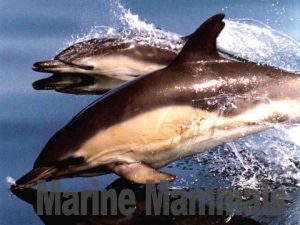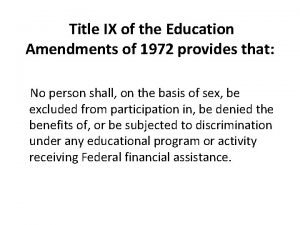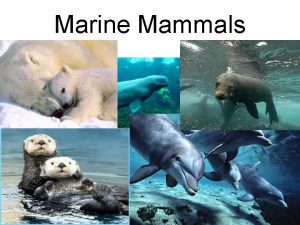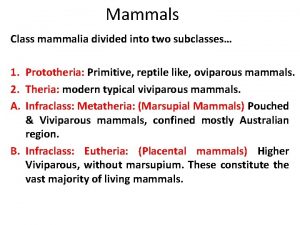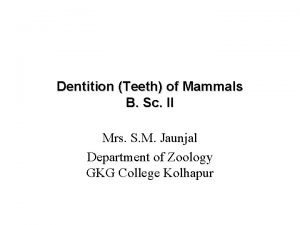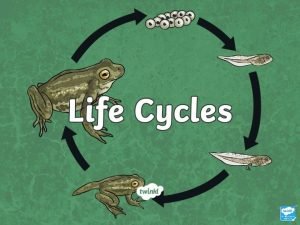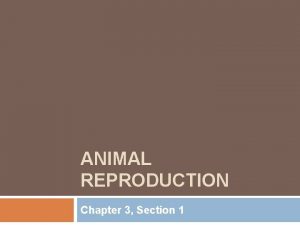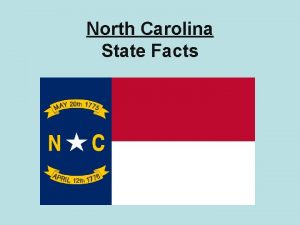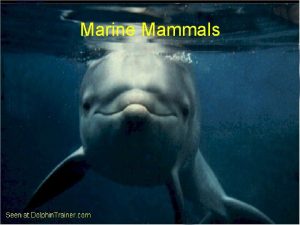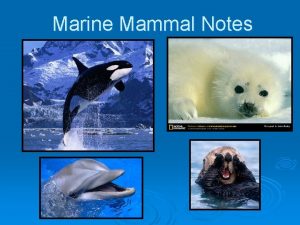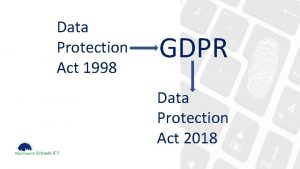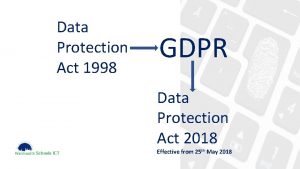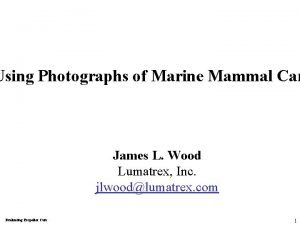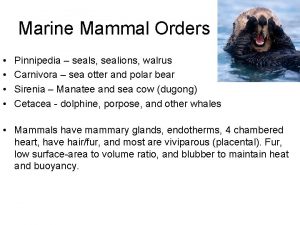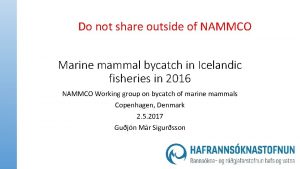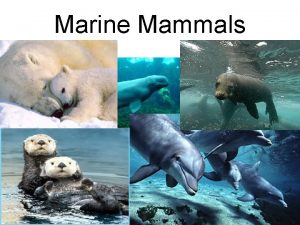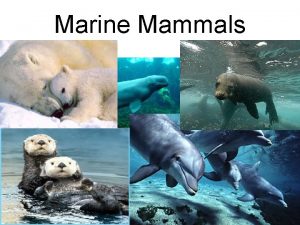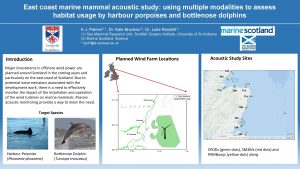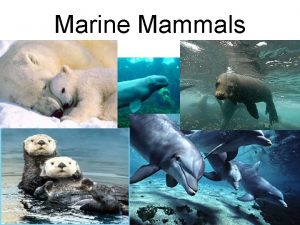Marine Mammal Protection Act of 1972 Chapter 4

















- Slides: 17

Marine Mammal Protection Act of 1972 Chapter 4, Module 3 1

Marine Mammal Protection Act of 1972 • Learning Objective: The student will become familiar with marine mammals, USFWS and NOAA jurisdiction and compliance options for the Marine Mammal Protection Act. 2

Marine Mammal Protection Act of 1972, as Amended • Signed into law in 1972 by Richard Nixon with the most recent comprehensive amendments in 1994. • U. S. Fish and Wildlife Service Jurisdiction: - Sea Otters, Polar Bears, Manatees, Dugongs and Walrus. • National Marine Fisheries Service - All other wild marine mammals (e. g. seals, dolphins and whales). 3

Marine Mammal Protection Act • Prohibits take of marine mammals, with limited exceptions. • Requires NMFS to maintain marine mammals at or above optimum sustainable populations. • Requires regular assessment of marine mammal stocks. • Requires development of conservation plans for depleted species. • Requires take reduction plans for strategic stocks (identified in list of fisheries). 4

Marine Mammal Protection Act • First legislation to mandate an ecosystem approach to marine resource management. – Primary objective to maintain the health and stability of the marine ecosystem. – Secondary objective to obtain and maintain Optimum Sustainable Populations (OSP) of marine mammals. – Establish specific regulation for depleted populations, i. e. , those below their OSP. 5

Optimal Sustainable Population • The number of animals which will result in the maximum productivity of the population or the species. • Keeping in mind the carrying capacity of the habitat and the health of the ecosystem of which they form a constituent element. 6

Marine Mammal Protection Act • Placed a moratorium on “Taking” and importing marine mammals and marine mammal parts except when authorized (e. g. , Letter of Authorization, Incidental Harassment Authorization, Native Exceptions, Fisheries Related Takes, Permits, Etc. ). • “Take” means to harass, hunt, capture, or kill or attempt to harass, hunt, capture or kill any marine mammal 7

Definition of Harassment • HARASSMENT is any act of pursuit, torment, or annoyance which: - Has the potential to injure a marine mammal or marine mammal stock in the wild [Level A] - Has the potential to disturb a marine mammal or a marine mammal stock in the wild by causing disruption of behavioral patterns including, but not limited to , migration, breeding, nursing, breathing, feeding, or sheltering [Level B] 8

Harassment for the U. S. Navy and Federally. Funded Research is Slightly Different, as of 2003 • Any act which injures or has the significant potential to injure a marine mammal or marine mammal stock in the wild [Level A] • Any act which disturbs or is likely to disturb a marine mammal or a marine mammal stock in the wild by causing disruption of natural behavioral patterns including, but not limited to, migration, surfacing, nursing, breeding, feeding, or sheltering, to a point where such behavior patterns are abandoned or significantly altered 9 [Level B]

Incidental Harassment Authorization (IHA) • In 1994, Congress amended the MMPA to establish an expedited process by which citizens of the U. S. can apply for an Authorization to Incidentally Take small numbers of marine mammals by Harassment. – Whale Watching Industry 10

Marine Mammal Protection Act • An Incidental Harassment Authorization (IHA) may be obtained if: - There is no potential for serious injury or mortality; or, - The potential for serious injury or mortality can be negated through mitigation requirements that could be required under the authorization • If there is a potential for serious injury or mortality that cannot be mitigated, a Letter of Authorization is required 11

Marine Mammal Research • All research on marine mammals, including research to determine how they receive and react to sound, may be conducted ONLY under an approved scientific permit 12

Marine Mammal Protection Act Commercial Marine Fisheries • Although the Act was stimulated by the take of Pelagic dolphins in the yellowfin tuna industry, the fishing industry is regulated under a more liberal set of requirements provided they: - Register - Accept observers - Comply with requirements of take reduction plans, and - Report all marine mammal mortalities or injuries. 13

Incidental Take Authorization or Letter of Authorization (LOA) • In 1998, Congress amended the MMPA to provide for “INCIDENTAL TAKE” authorizations for maritime activities, provided NMFS determined: - Takings would be of small numbers - Activities would have no more than a negligible impact on those species not listed as depleted - Activities would not have an unmitigable adverse impact on subsistence harvests 14

Type of Activities • Most LOAs and IHAs have involved the incidental harassment of marine mammals by noise. • Activities with the greatest potential to harass by noise include: - Seismic airguns - Ship & aircraft noise - High energy sonars - Explosive detonations 15

Marine Mammal Protection Act • Provisions of the MMPA apply to all citizens of the united states conducting activities worldwide with the exception of activities within the territory of another country, in which case the laws of that country apply. 16

Marine Mammal Protection Act Take Away Points: • Consult - U. S. Fish and Wildlife Service - Sea Otters, Polar Bears, Manatees, Dugongs and Walrus. National Marine Fisheries Service - All other wild marine mammals (e. g. seals and whales). • USACE projects may need a “Take” authorization – to include harassment. 17
 What are the main characteristics of animals
What are the main characteristics of animals Wildlife act 1972
Wildlife act 1972 Characteristics of mammals
Characteristics of mammals West african manatee
West african manatee Australian marine mammal research centre
Australian marine mammal research centre Title ix of the education amendments act of 1972 prohibits
Title ix of the education amendments act of 1972 prohibits Object and scope of the payment of gratuity act, 1972
Object and scope of the payment of gratuity act, 1972 Mammal metamorphosis
Mammal metamorphosis What us a mammal
What us a mammal Mammal subclasses
Mammal subclasses Characteristics of carnivores
Characteristics of carnivores Class object in java
Class object in java Types of mammalian teeth
Types of mammalian teeth Life cycle of birds
Life cycle of birds Mammal reproduction
Mammal reproduction If an animal has hair then it is a mammal. (converse)
If an animal has hair then it is a mammal. (converse) South carolina state bird name
South carolina state bird name Animal life cycle stages
Animal life cycle stages



